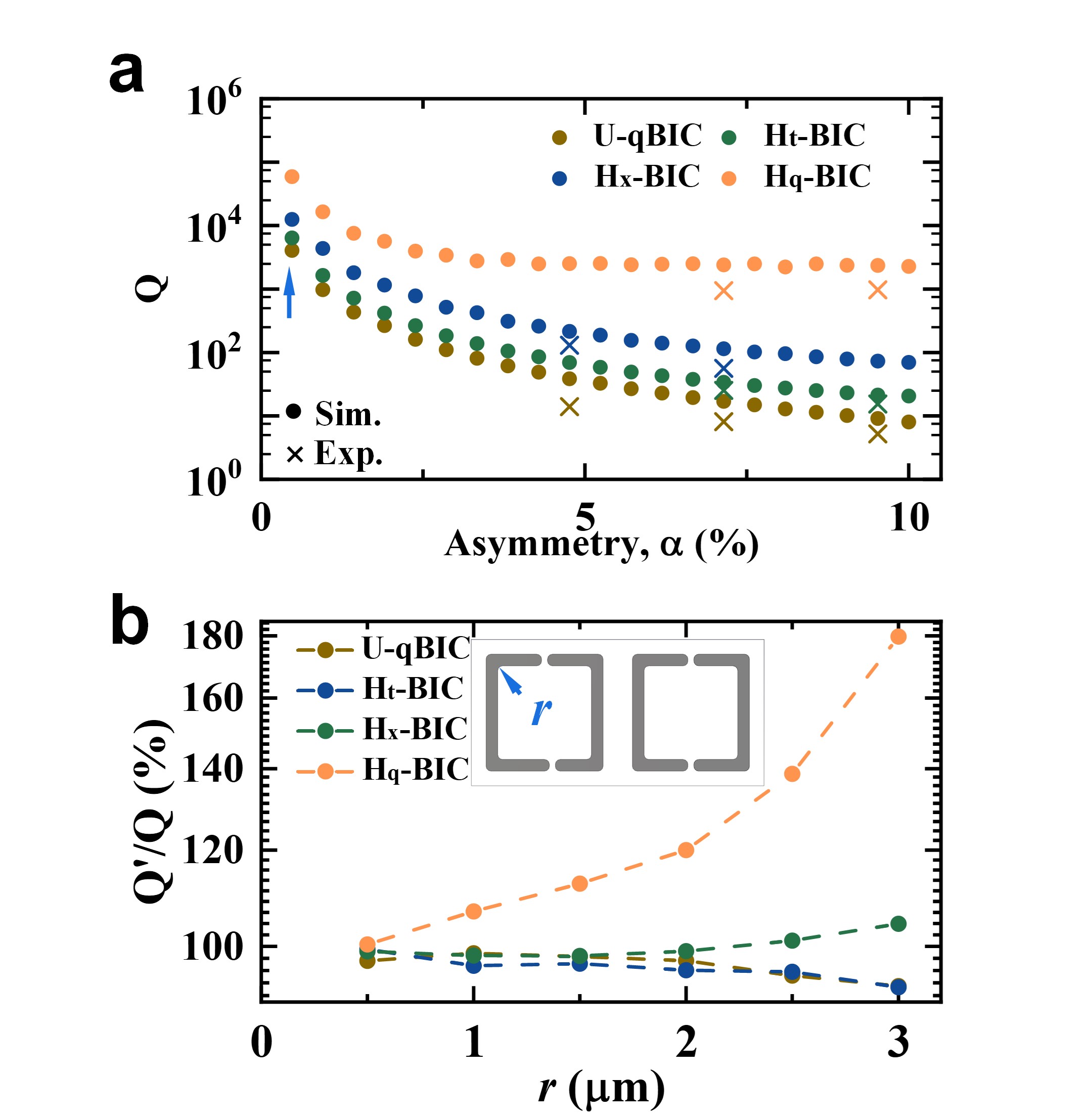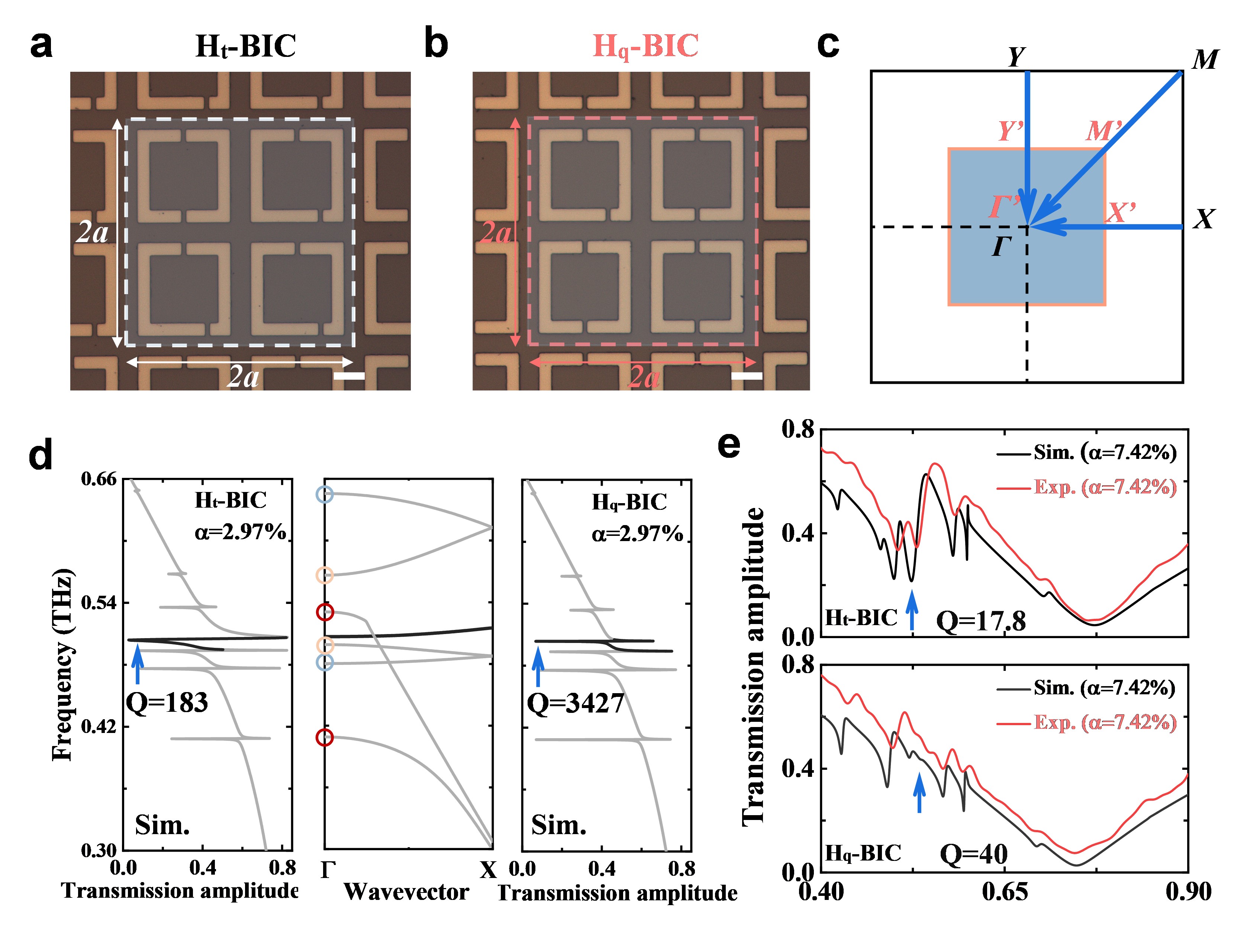| May 26, 2023 |
Hybrid bound states in the continuum in terahertz metasurfaces
(Nanowerk News) The quality factor (Q) is a critical parameter that characterizes the strength of light-matter interactions. Cavities with higher quality factors have the ability to efficiently confine light and thus enhance light-matter interactions. This feature holds significant importance in various applications such as lasers, filters, harmonic generation, and sensors.
|
|
Different schemes have been proposed to improve quality factors in microcavities, such as microdisks, Bragg reflector microcavities, and photonic crystals. Above the light cone of band structures, bound states without radiative leakage of energy are also accessible, namely bound states in the continuum (BIC).
|
|
BIC provides a generalized method to obtain ultrahigh quality factor resonances, thereby becoming a powerful mechanism to enhance light-matter interactions that have found applications in low-threshold lasers, multi-spectral sensing, and high harmonics generation.
|
 |
| Fig. 1 Hybrid BIC lattices. (a-c) Schematic diagram of symmetry-protected BIC lattice without radiation channel (a), uniform quasi-BIC lattice with radiation channel open for all the resonators by breaking symmetry (b), and hybrid quasi-BIC lattice with half radiation channel open interchanging along x axis (c). (© Opto-Electronic Science)
|
|
For a typical BIC, there is a quadratic quantitative relation between Q and wave vector (k), and usually a tiny disturbance in k would lead to a rapid deterioration of Q. However, defects and disorders are inevitably introduced during processing which greatly reduce the quality factor of resonances in actual samples.
|
|
The idea of merging BIC starts with modulating the exponential coefficient between Q and k (from -2 to -6), which largely alleviates the deterioration rate of Q and provides a very effective mechanism. But this approach requires precise control of the geometric dimensions of microstructures and is only applicable to band structures that simultaneously have symmetry-protected and accidental BICs, with rather harsh requirements.
|
|
Recently, Longqing Cong's group at Southern University of Science and Technology (SUSTech) proposed a more generalized approach to improve the overall quality factors and robustness of symmetry-protected BIC. Unlike the conventional approach of achieving quasi-BIC by breaking symmetry of resonators uniformly in the entire lattice of metamaterials (see Fig. 1a and b), they selectively maintain the local C2 symmetry of the entire lattice so that radiative loss could be decreased and the quality factor of the array is improved (see Fig. 1c).
|
 |
| Fig.2 Significant Q improvement in hybrid BIC lattices and robustness against fabrication imperfections. (a) Evolution of radiative Q versus asymmetry degree for U-qBIC, Ht-BIC, Hx-BIC and Hq-BIC lattices. The overall quality factors are improved in hybrid unit cells with a lower radiation density. (b) Influences of fabrication imperfection on quality factors in the four scenarios. (© Opto-Electronic Science)
|
|
This is a generalized method that could be extended to any symmetry-protected BIC without requirements of accurate geometric design or band selectivity. According to qualitative and quantitative analysis, the hybrid BIC lattice can achieve a quality factor more than 14.6 times higher than that of the conventional lattice (Fig. 2a). By increasing the proportional coefficient between Q and k, the quality factor robustness of the hybrid BIC metasurfaces against disorders and other disturbances is improved, thereby effectively reducing the deterioration of the quality factor in actual devices. This provides a more generalized and simple approach to achieving a high-quality factor (Fig.2b).
|
|
Through reciprocal space analysis of the lattice, the hybrid BIC lattice can simultaneously fold the eigenstates of the X, Y, and M points of the uniform BIC lattice to the ?? point, so that multiple Fano resonances can be observed in the far-field radiation (Fig. 3).
|
 |
| Fig.3 Generalized high-order hybrid BIC. (a, b) Microscopic images of Ht-BIC and Hq-BIC metasurfaces with three and one asymmetric resonators out of four in a 2??2 supercell, respectively, and the period is 2a along both x and y axes. Scale bar, 20 µm. (c) Schematic diagram of band folding from U-qBIC lattice (black) to Ht-BIC/Hq-BIC (red) in the Brillouin zone. (d) Simulated transmission amplitude spectra of the Ht-BIC (left) and Hq-BIC (right) metasurfaces at asymmetry degree of 2.97%. (© Opto-Electronic Science)
|
|
Multiple high-quality factor Fano resonances are very important in pulse generation, sensing, communication, etc., especially for the development of sensing and next-generation wireless communication based on terahertz photonics. This offers novel insights into fusing metasurfaces and terahertz photonics to facilitate their development in diverse fields. This work will further enrich the physical implication of BIC and broaden the perspective of metamaterials and terahertz photonics.
|
|
The team published their finding in Opto-Electronic Science ("Hybrid bound states in the continuum in terahertz metasurfaces").
|



